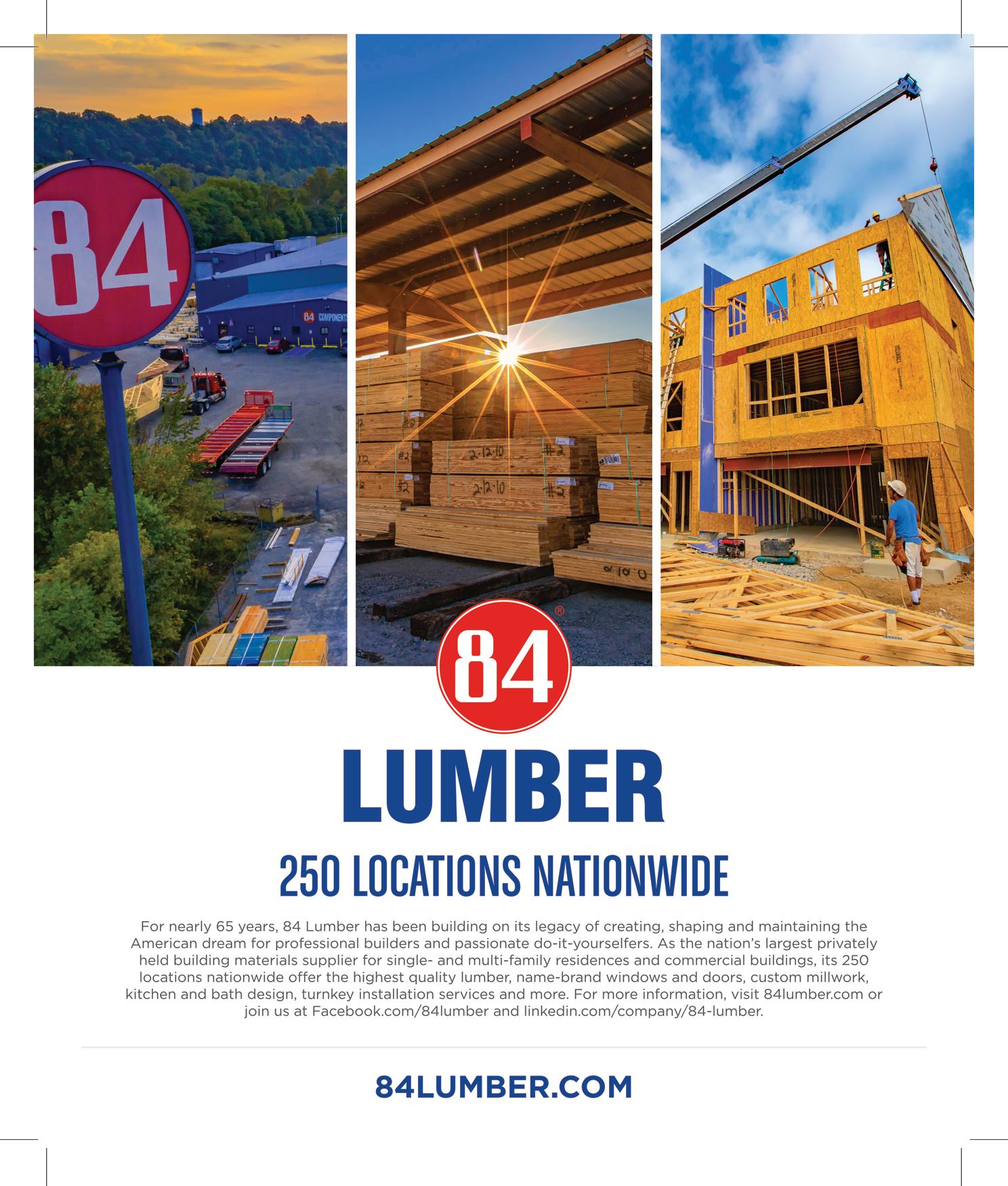
10 minute read
Huge demand puts pressure on treated lumber
from HBSD-1220
by ensembleiq
Pressure from treated lumber
Shortages and high price points cause disruption in pressure treated lumber dynamics.
By Andy Carlo
Pressure treated lumber was both a blessing and thorn in the side of pro dealers in 2020.
COVID-19 regional lockdowns pushed DIYers to do more while stuck at home. The end result was a massive surge in demand for treated lumber.
As home improvement projects took hold in the spring and summer months, including new decks, fencing and swing sets, the price of pressure treated lumber soared sky-high while overall supply became scarce at times.
But it appears that the cost of treated lumber is settling back down to lower price points in the fall season. Now it’s a question of what’s ahead for treated lumber in 2021 and how do dealers respond?
In mid-April of 2020, pressure treated lumber began a ride that saw materials rise week after week until mid-September before reaching all-time-high price points. The overall cost increased by about 200% during that span.
For example, treated 2” boards reached a price level well over $1,000/ MBF (1,000 board feet) while decking hit levels as high as $2,000/MBF. Timbers also increased by as much as 175%, reaching over $1,000/MBF.
Prices began to drop harder than anyone anticipated in September, however.
According to Angie Maxwell, treated products manager at LBM Advantage forest products and building materials buying group, the price points prompted some dealers to allow their pressure treated supply to run out rather than being stuck with high-priced lumber as prices began to recede.
“Right now, everyone has very thin inventory,” Maxwell told HBSDealer.
Some of what triggered the price drop was a sizeable drop in demand. Many of the projects that might have taken place during the fall building season were already completed in summer and spring. Additionally, suppliers have been able to play catch up with inventory levels and now sit at a more comfortable position than where they were in the summer months.
During the height of the price climb, suppliers weren’t in a solid position and in some cases found difficulty obtaining the chemicals needed to treat lumber. This caused dealers to not know when they would actually receive orders. And when orders were delivered, treated lumber was quickly out the door to job sites.
“Multiple variables now have to be weighed by treaters and dealers alike,” said Steve Sallah, CEO of LBM Advantage.
Sallah points out that existing home sales have been strong, however. That translates into repair and remodel projects including new decks.
Remodelers were also impacted by lumber shortages in the third quarter
2020 saw sky-high price increases for pressure treated lumber.
of 2020. According to the National Association of Home Builders (NAHB) Q3 Remodeling Market Index, more than 70% of remodelers reported a lumber shortage with 25% saying there was a serious shortage.
With treated lumber being problematic in 2020, composite decking manufacturers have stepped up their game while meeting market demand.
“The demand for both wood and wood-alternative decking continues to increase as homeowners invest in outdoor living projects,” said Jase DeBoer, senior marketing manager at Deckorators. “As more homeowners take on DIY projects, the availability of wood has led to many considering entry-level, low-maintenance composite decking for their outdoor projects.”
Deckorators embraced the opportunity by introducing Trailhead decking, an affordable entry-level decking solution that maintains many of the features builders and homeowners have come to expect from woodalternative decking, the company says.
Toby Bostwick, vice president of product and brand at Fortress Building Products, said the company is seeing lumber shortages and rising prices on treated lumber drive decking and framing trends on a macro level.
“For those participating at the lowend price point, traditional composite decking is getting significant play,” Bostwick says. “The boards are readily available, durable and beautiful. And with the price point between composites and wood narrowing, it’s becoming a much easier conversion for the channel.”
Fortress is also seeing more contractors upsell high-end alternatives like capped PVC decking when they can’t get enough treated products.
On the framing front, Fortress is seeing a growing demand for lightgauge steel. “Composite and PVC decking can now last 25 years or more, and homeowners want framing systems that can match the longevity of their
Given the price of lumber, how likely is steel framing to emerge as an attractive alternative to wood framing in home construction? 19%
Very likely to happen

38% It won’t happen
43% It might happen
Source: HBSDealer Poll Question.
surface boards,” Bostwick explains. “Contractors are also tired of getting callbacks when traditional frames twist, rot or dry after just 10 years.”
While steel’s price point was already starting to make sense against this backdrop, the lumber shortage has really changed the game. Pent-up project demand has brought a heightened awareness to the fact that builders don’t have to stall projects when pressure treated lumber is unavailable.
Bostwick says that many builders took this opportunity to educate themselves and their customers about the merits of steel. “Now, homeowners are seeing just how beautiful the framing material can be. Contractors are also less intimidated handling the
—Jase DeBoer, Senior Narketing Nanager, Deckorators new material, finding steel installs similar to wood, with posts and joists.”
Thanks to people’s design-oriented mindset, interest in higher-end alternative decking continues to climb with no signs of slowing down, especially considering it’s readily available. People are also spending more time outdoors and at home than ever before, so it’s no surprise that customization and durability continues to be a growing priority for homeowners renovating outdoor living spaces.
“Whether customers want a curved deck, boards with variegation or the visual continuity of carrying hardwoods’ aesthetic from the indoors out, high-end alternatives like capped PVC allow for more seamless customization than pressure treated lumber,” Bostwick says.
DeBoer said that Deckorators has been producing and shipping its decking products as quickly as possible due to high demand. And regarding whether the market remains hot, he says the company’s contractor customers are booked well in 2021.
“If you want a new deck for next summer, you had better contact a contractor now,” DeBoer says.
Operation: Military Influence
By Ken Clark
Across the industry, the steady drumbeat of initiatives to support military service members and their families seems to sound louder each year. And each November, around Veterans Day, the drumbeat intensifies well beyond merely providing discounts at the point of sale to veterans.
In Maine, there’s Hancock Lumber’s support for the Hire-a-Vet program. In Virginia, TW Perry contributes in many ways to the Yellow Ribbon Fund, assisting injured service men and women at the Walter Reed Army Medical Center. Home Depot recently announced a plan to cover mortgage payments for 500 veterans in need as part of its second annual Veterans Day Operation Surprise initiative.
The list of industry programs that support the military goes on far too long for an adequate roll call of examples. But the power of these programs is partly based on the fact that companies support

Joe Hardy enlisted in the Army Air Forces in WWII. He left the service as a lieutenant, and went on to become the founder and driving force of 84 Lumber. veterans not out of a desire for publicity, but out of a real connection to the military and a desire to do right by those who volunteer for their country. During an HBSDealer
Webinar last month, 84
Lumber’s VP of Marketing
Amy Smiley described its recruitment approach. ”At 84 Lumber, some of our recruiting efforts are focused around veterans because we’ve found that veterans make really great associates at our company,” she said “We have a lot of those same core values as the military.” At 84 Lumber, the company’s success most certainly leaned on values brought to business from the military by founder Joe Hardy. Similarly, Stine Lumber of Sulphur, La. — also founded by a WWII vet and a successful privately held company — owes some of its

J.W. Stine, backrow center, served as a B-26 pilot in WWII. After the war, he created an LBM business that eventually became Stine Lumber Co.

success to the core values of its founder J.W. Stine, and many of the core values of military service.
What are those core values? HBSDealer reached out across the industry for veterans who would volunteer to describe in their words just how their military experience has influenced their business career.


Dan Berry President Paradise Home Center Union, S.C. “Serving in the US Army as a West Point infantry officer instilled three things: attention to detail, training, and Gina Workman Employee relations manager/training and development Ace, The Helpful Hardware Company Alpharetta, Ga. perseverance. All three translate well in serving our community as president of a family-owned home center. You have to be committed for the long haul and strive for excellence and professionalism in every area.”


John Colley Director of purchasing Zeeland Lumber “I served as a United States Marine from 1988 to 1992. All the military leadership traits and principles have certainly helped me, but I was assigned to a Fleet Service Support Group at the end of Operation Desert Storm that opened my eyes to logistics. The experience really helped instill the mindsight of getting people what they need, when they need it, at a price they are willing to pay. It is not much different with building materials… except the need may be more often a want sometimes!”


Zeeland, Mich.
“My service in the United States Navy has influenced our business and my business career, for these reasons, the passion to serve my country, the leadership experience I acquired, and the desire fueled to stand on the principles of Honor, Integrity, and Service has given me the tools to effectively lead, influence, and motivate our team and our business to achieve success and to serve our customer’s and community.” Sean Norem Manager sales and operations planning LP Building Solutions Nashville, Tenn. “I served in the United States Marine Corps in the infantry. My time as a Marine taught me many leadership lessons and principles that I will use the rest of my life. Most importantly, putting your people first and leading with your actions, not just your words. Another daily requirement was the ned to adapt to your environment and situation. No plan ever goes exactly how it is drawn up. You must be able to make swift, educated decisions depending on what is happening around you.”


Chris Yenrick President and COO Smith Philips Building Supply Winston-Salem, N.C. “My military experience gave great opportunities and lessons in resilience, leadership, responsibility, and teamwork. I was both enlisted and an officer, the training both Basic Training and Officer Candidate School, were tough mentally and physically but developed great team environments and sense of responsibility to the team. In addition to learning people skills, my specialty as a Medical Service Corp Logistics Officer, taught me a great deal of skills in warehousing, customer service, planning, transportation, contracting, and information technology, all highly applicable to success in the building material world.”

CONFIDENCE
BUILDING YOUR BUSINESS







